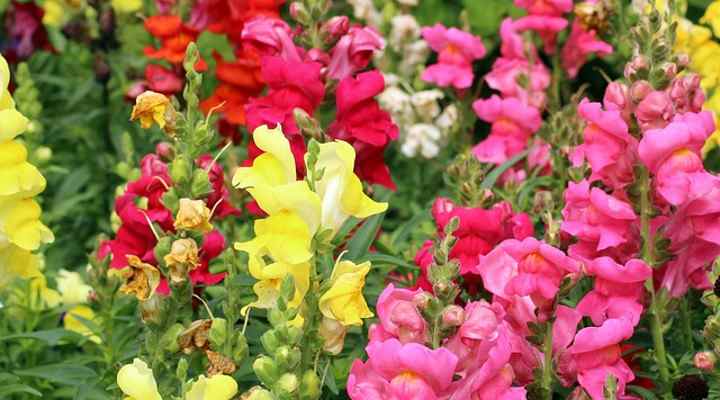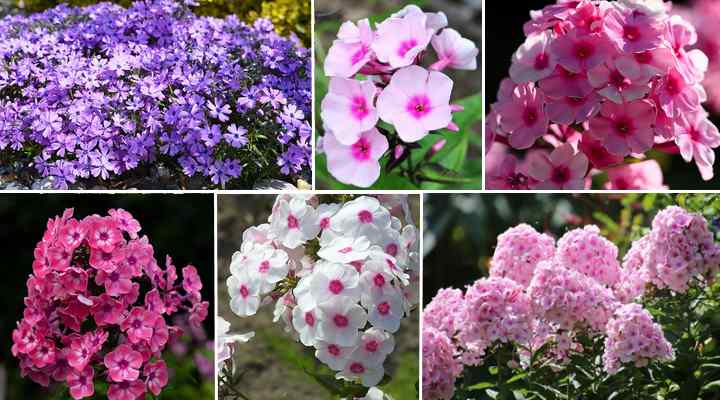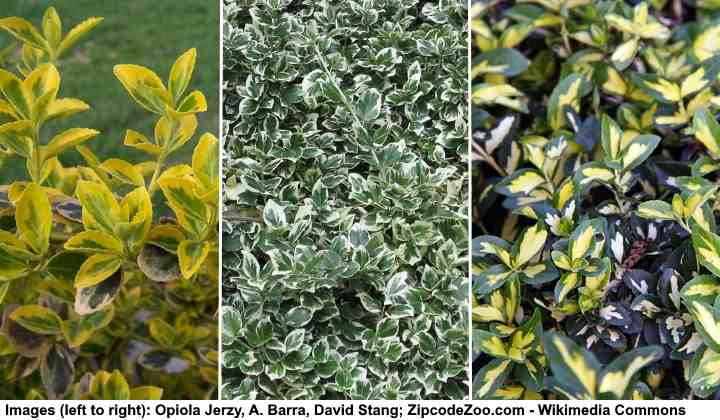The Best Foundation Plants for Front of House Landscaping (Pictures) – Identification Guide

Foundation plants for the front of house can create a terrific impression of your property. Front-of-house flowers, shrubs, and evergreen bushes help blur the line between your yard and home and add fantastic curb appeal. Foundation planting helps transform the appearance of your front yard by adding greenery, a pop of bright colors, and floral aromas.
The best foundation plants for your yard should be easy to grow without requiring much maintenance. Low-growing shrubs, dwarf evergreen conifers, ground cover plants, and flowering perennials are also types of common foundation plants. For beautiful landscaping, growing a mixture of evergreen, deciduous, and flowering shrubs can give your front yard visual appeal throughout the year.
This article is a guide to choosing the best shrubs and plants to grow around a house foundation. Descriptions and pictures of suitable plants for front yard landscape design will help you plan a stunning garden that will be the envy of the neighborhood.
Why Choose Foundation Plants for the Front Yard?
Foundation plants serve several purposes for landscape design in the front yard. First, low-growing shrubs and perennial flowers hide the property’s foundations. Second, dwarf flowering shrubs brighten up your front yard landscape. And lastly, growing thorny bushes around your property’s perimeter increases security in an unobtrusive way.
How to Choose Foundation Plants
Choosing the best foundation plants for your front yard shouldn’t be challenging. First, pick shrubs, hedge plants, perennials plants, or flowering annuals with a mature height lower than the window ledges. Then decide on the visual effect you want to create — plant taller shrubs at the back and smaller, flowering plants at the front.
Sun exposure, soil type, watering needs, and USDA growing zones are other considerations when choosing plants to hide your home’s foundation line. It is also a good idea to consider the plant’s roots because invasive shrubs with shallow root systems could impact the property’s foundations.
For example, the best foundation plants for the east side of the house would be shrubs and bushes that thrive in partial shade. However, full-sun foundation plants or ground cover plants are ideal for the south or west side of a property.
Flowering Foundation Plants
Flowering foundation plants are great additions to any garden. Not only do they look gorgeous, but they also add a great deal of color and fragrance, making your summer days much more enjoyable. In addition, flowering foundation plants like pansies, marigolds, and petunias provide a habitat for pollinators.
Petunia – Low Maintenance Flowering Foundation Plants

Petunia flowers come in a wide variety of colors and are a stunning addition to the front of house
Petunias are excellent flowering foundation plants due to their showy, colorful blooms of funnel-shaped flowers. Petunias grow 12” (30 cm) tall and 3 ft. (1 m) wide. This makes the low-growing flowers ideal for front-of-bed foundation planting. In addition, petunia flowers have many color combinations.
Petunias grow as annuals or tender perennials. The spreading flowering plants bloom in spectacular hues of vibrant red, bright pink, deep blue or lilac, white, and purple. Mounding petunia plants bloom from late spring, and the flowers persist throughout the summer until frost.
Further reading: Planting, Growing and Caring for Petunia Flowers.
Summer Snapdragon (Angelonia angustifolia)

Snapdragon flowers add beautiful look and a curb appeal to your front yard
Summer snapdragon is a vigorous flowering foundation plant suitable for the front-of-house area. This landscaping foundation plant has tall flower spikes growing 1 to 4 ft. (0.3 – 1.2 m) tall. The 8” (20 cm) long flowering spikes have showy blooms in red, pink, purple, yellow and white colors.
Summer snapdragon plants are ideal for planting along a foundation, back of the bed, or creating a mixed border. You can grow summer snapdragon in full sun as a beautiful floral annual in cold climates or a year-long tropical flowering plant in USDA zones 9 through 11.
Marigold (Tagetes)

Marigolds are showy low maintenance flowers that look great as foundation plants
Marigolds are ideal landscaping plants for adding a splash of warm colors to a foundation landscape design. Marigold flowers are large, orange or yellow pompom-type blossoms on tall stems. The yellow or orange aromatic flower clusters (corymbs) consist of small, ruffled florets forming a rounded flower head.
Planting marigolds at your property’s foundation produces a spreading mass of colorful flowers. Depending on the species, marigolds grow in USDA zones 2 through 11. Some low-growing varieties can be ideal as ground cover for full sun, only reaching 4” (10 cm) tall. Other varieties can reach up to 2 ft. (60 cm) tall.
Pansies (Viola)

Pansies include many color variations and are great for landscaping front of house
Pansies are beautiful front yard flowering plants that bloom in spring with beautiful yellow, white, red, purple, and multicolored flowers. Pansy flowers grow between 5” and 10” (12 – 25 cm) tall with a spread of up to 8” (20 cm). This makes pansies ideal annual or short-lived perennial flowering plants for edging the front of a mixed bed, planting a colorful border, or growing in front of taller foundation plantings.
There are over 600 species of pansies and hundreds of more cultivars. The herbaceous plants have a clumping habit with colorful 4- or 5-petaled blooms measuring up to 0.75” (2 cm) wide. Pansies are typically grown as annuals and thrive in full sun or dappled sunlight.
Azaleas (Rhododendron spp.)

Azalea bushes include many varieties with various sizes and flower colors
Azaleas have long been a favorite in the category of low-growing shrubs for the front of the house. The beauty of azalea plants for a front yard landscape is their showy blooms consisting of pastel-colored ruffled or frilly petals. The low maintenance shrubby foundation plants grow 2 to 4 ft. (0.6 – 1.2 m) tall and have trumpet-shaped flowers up to 3” (7.5 cm) wide.
Azalea shrubs are flowering perennials with leathery, deciduous leaves in temperate regions. In zones 6 and above, you can plant azaleas as evergreen flowering foundation plants to enhance your front yard’s aesthetics.
Related reading: How to care for azalea shrubs.
Hydrangea

Beautiful hydrangea shrubs add focal point to any landscaped garden
Hydrangeas are stunning foundation plants due to their huge, colorful flower clusters. Flowers blooming on hydrangea shrubs are round or umbrella-shaped corymbs that fill front yards with color from spring through fall. Hydrangea flowers measure between 4” and 14” (10 – 35 cm) across, depending on the species.
The best hydrangea shrubs for foundation planting are dwarf varieties that mature around 3 ft. (1 m) in height and width. Their clusters of blue, pink, white, or lavender star-shaped flowers bloom abundantly on the rounded bushes, making them ideal shrubs for front-of-house landscaping. Hydrangeas thrive in USDA zones 3 through 9 and prefer full sun or partial shade.
Related reading: How to care for hydrangea plants.
Roses (Rosa)

Roses are types of flowering shrubs that are famed for their beauty, scent, and wonderful flowers
Roses are among the most beautiful foundation plants you can grow at the front of the house. Shrubby rose plants bloom with showy flowers growing in a rosette pattern. There are so many species of roses you will find a color combination to suit your front yard landscaping.
Apart from shrub roses, hybrid tea roses, and miniature roses, there are also varieties of climbing roses that can grow up walls. These spectacular climbing plants can cover foundations and the side of buildings. Or you can grow the woody climbing plants over trellises or entranceways.
Flowering rose shrubs are useful for foundation plantings for more than their colorful flowers. The sharp woody spikes on rose plants mean they form a natural security barrier for growing around your property or under windows.
Perennial Foundation Plants
Perennial foundation plants are ideal for planting around a home’s perimeter in colder climates. The cold-hardy shrubs and bushes typically die back in late fall and return in the spring. Many perennial plants keep their leaves throughout the year and create an attractive border around your property.
Hostas

Hosta plants are hardy and are mainly grown in the shade for their attractive foliage
Hostas are the perfect low growing perennial foundation plants for the north side of a building. Hostas are perennial leafy, low-growing plants that perform just as well in the sun as in the shade. The clumping plants grow up to 2 ft. (0.6 m) tall and have broad, light-green or variegated leaves.
Some varieties of hostas also produce fragrant white or pale purple flowers growing on tall, upright stems. Due to their low-maintenance, low growth, and adaptability to most soil types, hostas are ideal foundation plants. In addition, they will create an attractive evergreen border at the front of beds.
Related reading: The best ground cover plants for shade.
Ornamental Grasses

Monkey grass (Liriope) is a low maintenance and easy to care for flowering grass-like plant that can enhance any garden’s landscape
Ornamental grasses used in foundation plantings create a soft texture along the building that is a change from typical foundation plants. Grasses for foundation plants can create an accent at the corner of the house, low edging along a foundation, or accent other low-growing shrubs and evergreen plants.
There are several types of ornamental grasses to plant in a front-of-house landscape. For example, monkey grass is a creeping, clumping flowering decorative grass that grows 9” to 15” (23 – 28 cm) tall. Other suitable ornamental grass varieties for foundation plants include blue oat grass (Helictotrichon sempervirens), spear grass (Stipa calamagrostis), and Japanese sage (Carex oshimensis).
Phlox

Phlox are low maintenance and easy to grow long blooming perennials that come is various colors
Phlox is a stunning flowering perennial for foundation planting due to its profusion of red, pink, white, and purple flowers. Depending on the variety, phlox can grow up to 5 ft. (1.5 m) tall. Phlox can also grow as a creeping, prostrate plant to cover bare patches of ground.
Phlox is a sun-loving, cold-hardy bushy perennial that thrives in USDA zones 3 through 9.
Lilies

Lilies are long-stemmed perennial plants that produce stunning large flowers and are excellent accent plants
Lilies are bulbous perennial plants with spectacular, heavy-scented flowers that look beautiful along the front of the house. You can plant lilies at the back of a bed where they grow between 2 and 6 ft. (0.6 – 1.8 m) tall. Lily flowers typically are shaped like a trumpet, and some showy flowers have recurved petals.
Lily flowers bloom throughout summer and are ideal for mass planting. The colorful flowers grow up to 6” (15 cm) and can be cup-shaped, bowl-shaped, or pendulous. The flowering perennial foundation plants thrive in USDA zones 3 through 8.
Evergreen Foundation Plants
Evergreen foundation plants retain their leaves and color all year round and can typically withstand severe conditions. The best evergreen foundation plants are dwarf conifers like arborvitae, Japanese yews, and juniper shrubs. Some foundation plants with attractive foliage like wintercreeper and coral bells also add a splash of color to your front yard.
Boxwood (Buxus)

Boxwood evergreen shrubs can be pruned to create rounded shape or low growing formal hedges
Boxwood shrubs are the perfect foundation plants for your front-of-house landscape. The evergreen plants have densely growing oval leaves, making them ideal for hedges, barriers, or privacy screens. In addition, because boxwoods grow 3 to 4 ft. (1 – 1.2 m) tall, they are ideal for planting at a foundation.
Boxwood shrubs are suitable for planting along a foundation on any side of the building. The evergreen bushy plant thrives in full sun or complete shade and performs best in USDA zones 5 through 9.
Related reading: The most attractive boxwood trees and shrubs.
Evergreen Dwarf Juniper

Blue Star juniper (Juniperus squamata ‘Blue Star’) has a spreading habit and doesn’t grow taller than 3 ft. (1 m) tall and 4 ft. (1.2 m) wide
Many dwarf varieties of evergreen juniper shrubs or conical junipers are suitable for front-of-house planting. Depending on your front yard landscaping needs, juniper shrubs can be flat-topped spreading shrubs, columnar shrubs with narrow growth, or low-growing ground cover evergreen plants.
Some varieties of juniper shrubs to grow beside a house include:
- Dwarf Japanese garden juniper (Juniperus procumbens ‘Nana’)
- Blue star juniper (Juniperus squamata ‘Blue Star’)
- Juniperus chinensis ‘Expansa Variegata’
- Common Juniper ‘Gold Cone’ (Juniperus communis ‘Gold Cone’)
Related reading: The best juniper shrubs and trees.
Evergreen Dwarf Arborvitae (Thuja)

Thuja occidentalis ‘Hetz Midget’ is one of the smallest arborvitae shrubs that grows 3 or 4 ft. (1 – 1.2 m) and can suit compact spaces
Dwarf arborvitae shrubs are excellent for planting in the front of house for year-long evergreen foliage. As perfect foundation plants, small arborvitae shrubs are best growing on the south or west side of a building. Varieties of arborvitae have soft light- to dark-green feather foliage and don’t grow taller than 4 ft. (1.2 m).
Dwarf, evergreen arborvitae shrubs thrive in USDA zones 3 to 7.
The best evergreen shrubs for foundation planting from the arborvitae cultivars include:
- Thuja occidentalis ‘Hetz Midget’
- Thuja occidentalis ‘Little Giant’
- Thuja occidentalis ‘Fire Chief’
- Platycladus orientalis ‘Aurea Nana’
Related reading: The best varieties of arborvitae shrubs.
Japanese Yew

The spreading low growth habit of Taxus x media ‘Densiformis’ makes it suitable as an evergreen ground cover plant
Several dwarf Japanese yew shrub varieties make excellent evergreen plants to cover a foundation line. Not only do the dwarf yew shrubs grow less than 4 ft. (1.2 m) tall, but they are also incredibly easy to trim into different shapes. Some yew foundation plants spread up to 15 ft. (4.5 m) wide, whereas others are columnar shrubs, ideal for hedgerows.
The best evergreen Japanese yew shrubs to plant in front of foundations are the following:
- Anglo-Japanese yew (Taxus x media ‘Densiformis’)
- English yew (Taxus baccata ‘Repandens’)
- Dwarf English yew shrub (Taxus baccata ‘Repandens Aurea’)
- Irish yew (Taxus baccata ‘Fastigiata’)
Related reading: Attractive yew trees.
Coral Bells (Heuchera)

Coral bells are great foundation plants that include many cultivars with colorful foliage
Coral bells are ideal evergreen foundation plants to add color to the front of house. The leafy, mounding plants grow in tidy clumps and reach up to 2 ft. (0.6 m) tall. The low-growing foliage plants give year-long color along the foundation line in shades of purple, green, red, and lime green. There are even coral bells plants with black leaves.
Coral bells are suitable for growing in USDA zones 4 through 9.
Wintercreeper (Euonymus fortunei)

The colorful foliage of small evergreen Euonymus shrubs add an ornamental element to any garden. This picture shows the compact cultivars: ‘Emerald ‘n’ Gold’, ‘Emerald Gaiety’ and ‘Moonshadow’
Wintercreeper is a versatile landscaping plant for front yards. The low-growing bushy evergreen shrubs have golden yellow and green foliage or creamy-white and green leaves. The low-maintenance shrubs grow 2 to 3 ft. (0.6 – 1 m) tall and up to 5 ft. (1.5 m) wide.
You can plant wintercreeper on the sunny side of your house, and it thrives in USDA zones 5 through 9.
Deciduous Foundation Plants
Deciduous foundation plants can significantly enhance your front yard landscaping. Typically, deciduous front-of-house plants bloom with spectacular flowers in spring and summer. In addition, there are plenty of deciduous plants to choose from that thrive in all growing zones.
Rose of Sharon (Hibiscus syriacus)

Many gardeners prize rose of Sharon flowering shrub because it produces stunning flowers in late summer when few shrubs are in bloom
The rose of Sharon is a beautiful flowering plant to add dramatic colors to your front-of-house landscaping. The deciduous shrub is known for its dense foliage and vibrant stunning flowers. The papery trumpet-shaped showy hibiscus flowers come in shades of pink, white, purple, or red. Occasional pruning can help keep this attractive landscaping plant below the height of your front windows.
Related reading: The hibiscus tree.
White Meadowsweet (Spiraea)

The stunning flowers of dwarf spirea shrubs create an attractive front of house landscape
Meadowsweet is a deciduous flowering plant for front of house landscaping. The attractive upright, rounded shrub blooms in spring and summer with large clusters of brilliant white flowers. In the fall, the shrub’s foliage turns your front yard into shades of reds, purples, and yellows before the leaves drop.
Most varieties of meadowsweet grow between 2 and 4 ft. (0.6 – 1.2 m) and are suitable for planting USDA zones 3 through 9 and full sun.
Japanese Barberry (Berberis thunbergii)

Golden Ring Barberry (Berberis thunbergii f. atropurpurea ‘Golden Ring’)
Barberry is a group of thorny bushes with stunning colorful red foliage made up of spoon-shaped leaves. The red shrubby plant is ideal for adding a pop of color to a front yard due to its red leaves, red stems, and red berries. Also, the sharp spiny branches make the plant suitable for adding a security hedge around your home’s perimeter.
Japanese barberry shrubs are ideal front-of-house plants in USDA zones 4 through 7. The eye-catching red landscaping bushes grow between 1 and 5 ft. (0.3 – 1.5 m) tall, depending on the cultivar. Japanese barberries thrive in full sun or partial shade.
Related articles:
